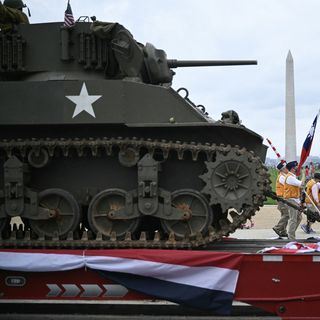10 celebrities who lived to 100 — and how they did it
Jessica McGowan/Getty Images
- These 10 celebrities made it to 100 years old and have tips on how they did it.
- Staying mentally and physically active can contribute to making it to triple digits.
- George Burns took brisk walks and avoided stress; Jimmy Carter credited marrying "the best spouse."
You might expect all Hollywood stars to have outlandish health and wellness routines, but these 10 celebrity centenarians kept it surprisingly simple.
Living to 100 is rare, but those who do tend to have some things in common. Scientists who study aging say that genes play a role in how long a person will live, but lifestyle factors, including diet, exercise, stress, and social connections, play a larger one.
From Jimmy Carter to the Queen Mother, here's what famous people who lived to 100 credit their longevity to.
Rich Fury/Getty
Iconic screenwriter and producer Norman Lear, who died in December 2023 at the age of 101, said that work (and loving his job) is what kept him going.
"Some people run. I don't run. I wake up and do the things that please me. That's my present to myself. That's my prayer. That's everything," he told USA Today as he turned 100 in 2022.
He reiterated this in a chat with the Los Angeles Times in 2020. "When I go to sleep at night," he said, "I have something that I'm thinking. Among other things, it's about something I'm doing tomorrow." He added, "So today is over, and we're on to the next."
There's evidence to suggest that delaying retirement could add years to your life. A 2015 study that followed 83,000 adults over 65 for 15 years, published in the journal Preventing Chronic Disease, found that, compared with people who retired, people who worked past age 65 were about three times more likely to report being in good health.
AP Photo/John Bazemore
The 39th president lived to be 100, dying in December 2024, almost three months after his landmark birthday.
He credited one person with helping him live that long: his wife, Rosalynn. They were married for 77 years before her death in 2023.
"It's hard to live until you're 95 years old," he told People in 2019. "I think the best explanation for that is to marry the best spouse: someone who will take care of you and engage and do things to challenge you, and keep you alive and interested in life," he said.
Research suggests that having strong social bonds can help you live longer. A 2021 meta-review published in the journal Frontiers in Psychology found that the link between social support and longevity is as strong as the link between not smoking and longevity.
Camerique/Getty Images
Bob Hope, known for his vaudeville, acting, comedy, and his hosting gig at the Academy Awards a record 19 times, died in July 2003, two months after his 100th birthday.
Back in the '80s, when he was a spry 78, he said he made sure to walk 2 miles every day, no matter where he was, per Men's Health.
He learned this lesson from his grandfather. "When he was 96 years old, he walked two miles to the local pub every day to get a drink. He died within a month of his 100th birthday, and he remained mentally sharp till the very end," said Hope.
There's science to back up their method. A 2024 study published in the British Journal of Sports Science analyzed health and mortality data from the 2019 US Census, the 2003—2006 National Health and Nutritional Examination Survey, and the National Center for Health Statistics. Using a mathematical model, the authors predicted that people who walk for around 160 minutes a day live an average of five years longer than their sedentary peers.
They speculated that if the least active Americans walked for an extra 111 minutes daily, they could live up to 11 years longer.
Michael Ochs Archives/Getty Images
Bob Hope lived to be 100, but his wife, Dolores, managed to outlive him. She died in 2011 at the age of 102.
While Dolores didn't publicly share theories on how she made it to triple-digits, her daughters had their own ideas. Her oldest daughter, Linda (who's now in her 90s herself), told ABC7 in 2009: "Laugh a lot. Laughter is something that's been part of our lives, and I have to think that is a large part responsible for their happiness and for their long lives."
Francois Durand/Getty Images
The "Gone with the Wind" star lived to be an impressive 104 years old. She died in July 2020.
De Havilland, in addition to crediting the "three Ls" (love, laughter, and light) with her longevity, told Vanity Fair in 2016 that she kept her mind sharp by doing The New York Times crossword every single day.
In a 2022 study published in the journal NEJM Evidence, 107 adults with mild cognitive impairment were asked to do an intensive program of web-based crossword puzzles or games for 12 weeks, followed by booster sessions up to 78 weeks. The authors found that 37% of participants in the crossword groups improved by two points on an Alzheimer's scale.
Alberto E. Rodriguez/WireImage/Getty
The Hollywood icon and star of films such as "Spartacus" and "20,000 Leagues Under the Sea" lived to 103. He died in February 2020.
Douglas wrote an essay for Newsweek in 2008, when he was 91, about growing old.
"Humor helps longevity," he wrote.
"Try to think of others, try to help them. You will be amazed how that lessens your depression. That satisfaction is priceless," he added. "The greatest dividend to old age is the discovery of the true meaning of love."
20th Century Fox
Much like her "Titanic" character Rose, Stuart lived to become a centenarian, briefly. She turned 100 in July 2010 and died two months later.
As her 1999 memoir, "I Just Kept Hoping," suggests, Stuart used her career to fuel her into her old age. "I was driven then [in the 1930s], and I'm driven now," she told SF Gate at the time.
After Stuart's death in 2010, NPR host Ari Shapiro added, "Her daughter says that during her long life, her mother did not believe in illness. She paid no attention to it, and it served her well."
Tim Graham Photo Library/Getty Images
The Queen Mother died in 2002 at the age of 101. Clearly, longevity runs in the family, as her daughter, Queen Elizabeth II, lived to be 96 before dying in September 2022.
The Queen Mother had some frank advice for living a long life.
In her official biography, she said, "'Wouldn't it be terrible if you'd spent all your life doing everything you were supposed to do, didn't drink, didn't smoke, didn't eat things, took lots of exercise, and suddenly, one day, you were run over by a big red bus and, as the wheels were crunching into you, you'd say, 'Oh my God, I could have got so drunk last night.' That's the way you should live your life, as if tomorrow you'll be run over by a big red bus."
Richard Drew/AP
The vaudeville star and comedian knew people would be curious about how to live to 100, so he decided to write the book "How To Live To Be 100 Or More."
Burns, who died in March 1996 at 100 years old, told UPI Hollywood, "You'll be happier and live longer if you find a job you love; that way you avoid stress. Never take stress to bed with you. Work on it in the morning."
He also confirmed that he did 45 minutes of exercise every day before taking a "brisk 15-minute walk around the neighborhood." He also had "two or three drinks a day" and always had a cigar close by (though, according to him, he never inhaled). He steered clear of cigarettes, however.
Being active is linked to living longer in better health. A 2022 study published in the British Journal of Sports Medicine found that of 99,713 participants aged 55 to 74, those who did regular aerobic exercise and strength training were 41% less likely to die from any cause in the seven to 10 years after.
"I don't believe a lot of this medical stuff. They say everything you eat and drink causes cancer. Don't pay too much attention to that," Burns added.
Chris Pizzello/Invision/AP
Saint, the oldest living and earliest surviving Oscar winner, will turn 101 in July 2025.
"I continue to take walks out in the fresh air, like watching baseball — especially the Los Angeles Dodgers, and enjoy time with my family and friends," she told People ahead of her 100th birthday last year.
A 2023 study published in BMC Medicine found that never being visited by friends and family was associated with a 39% increased risk of early death.



/2025/06/06/1749239424594.gif)

